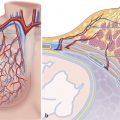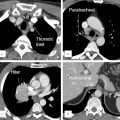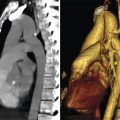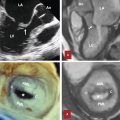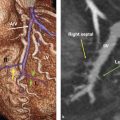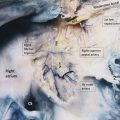2 Tracheobronchial System
Introduction
Anatomical knowledge of the trachea, mainstem bronchi, segmental bronchi branch pattern, relationship with neighboring structures and anatomical variants are important for radiologists and pulmonologists to localize, diagnose, and treat lesions.
Advanced bronchial endoscopic techniques as well as the possibility of virtual bronchoscopy using high-resolution computed tomography (CT) images have opened new ways to study the bronchial system. Multislice CT scanners can cover the entire lung during a single breath hold to create high-quality volumetric data allowing generation of superb multiplanar and volume-rendered images including specific postprocessing techniques for airway imaging, such as virtual bronchography and virtual bronchoscopy. Dynamic CT acquisition allows evaluation of the bronchial wall integrity and function during different phases of the respiratory cycle.
In this chapter, the anatomy and anatomical variants of the tracheobronchial tree will be reviewed and relevant pathologies will be discussed. At the hilar level the relationship of the bronchi to the pulmonary arteries and veins will be reviewed.
Embryology
Tracheobronchial and lung growth is subdivided into five distinct stages: embryonic, pseudoglandular, canalicular, saccular, and alveolar. 1 , 2 , 3 , 4 While there is some overlap of these stages, it is generally agreed that weeks 0 to 6 of gestation comprise the embryonic stage, weeks 6 to 16 the pseudoglandular stage, weeks 16 to 24 the canalicular stage, weeks 24 to term the saccular stage and the alveolar stage continues during the first 3 years of postnatal life. Development of the pulmonary circulation occurs in parallel with lung development. The respiratory portion of the gut will be separated from the esophageal portion by the tracheoesophageal septum which is formed from the lateral ingrowths of the surrounding mesoderm.
The rudiment of the respiratory tree develops as a median laryngotracheal diverticulum (lung bud) arising from the anterior wall of the foregut between third and fourth week of embryonic development. 1 , 2 Shortly thereafter, the right and left lung buds appear, the laryngotracheal tube forms, and the trachea separates from the esophagus. The thyroid cartilage develops from the ventral ends of the cartilages of the fourth branchial arch and the cricoid cartilage and cartilages of the trachea develop from the sixth branchial arch during the sixth week. The trachea increases rapidly in length from the fifth week onward. Three growing points on the right side and two on the left side corresponding to primary lobar bronchial buds soon appear. 2 During the embryonic and pseudoglandular stages each primary bronchial bud undergoes rapid and continuous stages of dichotomous arborization that, by birth, gives rise to 18 to 23 generations of bronchial divisions. Therefore, by week 17 (end of the pseudoglandular stage), all preacinar airways, as well as corresponding vessels are present and the acinar limits can be identified. 1 During this period, the airways are blind tubules lined by columnar or cuboidal epithelium, hence the term pseudoglandular. Terminal bronchiole, respiratory bronchioles, and alveoli develop mainly during the canalicular and saccular stages (24 weeks till birth). Differentiation of the cuboidal epithelium into type I and type II cells, initiation of air–blood barriers, and the start of surfactant production also occur in these stages and the lungs migrate inferiorly, so that by birth the bifurcation of the trachea reaches the level of T4. At birth, further maturation of the lung parenchyma and the surfactant system continues during the first few years of life. Infants born prematurely have underdeveloped lungs (pulmonary hypoplasia) and often require assistance to maintain adequate respiration. Lung growth is influenced by physical factors such as the amount of amniotic fluid, lung liquid volume and pressure, and fetal breathing movements. 5 , 6 , 7
Any defect during embryonic development of the tracheobronchial tree can result in congenital malformations. Incomplete separation of the trachea from the foregut can cause various forms of tracheobronchial fistulas. Abnormalities of the bronchial branching pattern occur during embryonic and pseudoglandular stages. It is likely that defects causing supernumerary tracheal bronchi occur during the early embryonic stage (before week 6), at about 29 to 30 days, as the lobar bronchi start to differentiate, whereas displaced bronchi are more likely to occur during pseudoglandular stage (after week 6). 8 , 9 , 10
Tracheal Anatomy
The trachea is a cartilaginous and membranous tube located below the subglottic region. The subglottis or subglottic region is a short airway passage in the lower portion of the larynx that extends from a plane approximately 1 cm below the free margin of the true vocal cords to the lower border of the cricoid cartilage 11 , 12 , 13 , 14 (Fig. 2‑1 , Fig. 2‑2 , Fig. 2‑3). The trachea extends between the cricoid cartilage at C5–C6 level and the carina approximately at T4–T5 level 11 , 12 , 13 , 14 (Fig. 2‑4).
In the adult, the tracheal length ranges from 10 to 16 cm. The adult trachea is, on average, 15 cm long. It is longer in men than in women. The first half of the trachea is located above the thoracic inlet when the neck is extended but it becomes entirely intrathoracic in hyperflexion position. Surgeons leave the neck in a neutral position to decrease tension on trachea after segmental tracheal resection. Position of the neck is also important when assessing the position of endotracheal tubes (ETs) on chest radiograph. With flexion, the end of the ET can easily move from a midtracheal position to the carina or even lower into the orifice of the right main bronchus (Fig. 2‑5).
The trachea moves in midline from an anterior position at the neck to a posterior position at the carina. The trachea often can be deviated to the right at the level of the aortic arch, with a greater degree of displacement in the setting of advanced age or aortic dilation and tortuosity. Anatomical relationship of the trachea to adjacent organs can best be assessed with CT. In the neck, the thyroid and thyroid isthmus cover the second or third tracheal rings of the trachea anteriorly and the esophagus moves behind the trachea. In the mediastinum, the innominate artery crosses over the midtrachea obliquely from its site of origin in the aortic arch and the right and left brachiocephalic veins are located anterior to the innominate artery (Fig. 2‑6 , Fig. 2‑7). The superior vena cava is anterior and to the right of the trachea. Posteriorly, the membranous trachea is in contact with the esophagus on the left and vertebral bodies on the right.
The trachea has an anterior and lateral U-shaped cartilaginous portion and a posterior membranous part lined by ciliated pseudostratified respiratory columnar epithelium. The membranous part consists of fibrous sheath with smooth trachealis muscle. The trachea is made of 16 to 22 cartilaginous rings connected each other by elastin tissue. Each ring is approximately 0.5 cm in length. With age, the cartilaginous portion becomes more rigid and calcified. In CT studies of the chest, calcification of the tracheobronchial tree is common finding in patients aged 40 years and older especially in women (Fig. 2‑8). Practical clinical significance of tracheal calcification remains unknown. It is more common in patients who have been on long-term anticoagulation medication, such as warfarin sodium. In general, senile calcification occurs commonly in structures made of hyaline cartilage (e.g., thyroid, cricoid, and part of the arytenoid cartilages, and tracheal rings), but it is rare in structures made of elastic fibrocartilages. 11
The average diameter in a normal trachea is 22 mm in men and 19 mm in women. 15 The cricoid cartilage is the narrowest part of the trachea with an average diameter of 17 mm in men and 13 mm in women. In men, the coronal diameter ranges from 13 to 25 mm and the sagittal diameter ranges from 13 to 27 mm. In women, the average coronal diameter is 10 to 21 mm and the sagittal is 10 to 23 mm. 14 , 16 The tracheal lumen narrows slightly as it moves toward the carina. The cartilaginous tracheal wall is about 2 to 3 mm in thickness in both men and women, with a tracheal lumen that is often ovoid in shape.
The trachea is a dynamic and distensible organ that changes in diameter with respiration and variation in intrathoracic pressure (Fig. 2‑9). On inspiration, the cross-section appearance of the trachea is usually U-shaped especially in men and less commonly elliptical especially in women. 17 On expiration, posterior membrane flattens or bows anteriorly causing up to 30% decreased sagittal diameter in normal individuals. Chronic obstructive pulmonary disease (COPD) may lead to enlargement of the trachea (saber-sheath appearance) and in some cases softening of the tracheal rings (Fig. 2‑9). Saber-sheath trachea refers to diffuse coronal narrowing of the intrathoracic portion of the trachea with the concomitant widening of the sagittal diameter.









Vascular and Nerve Supply
Arterial supply to the proximal trachea is mainly provided by the tracheoesophageal branches of the inferior thyroid artery. The distal trachea on the other hand is supplied by the bronchial arteries. 11 , 12 , 13 Small branches arising from the subclavian, internal mammary, and innominate arteries also supply the trachea. The tracheoesophageal arteries divide into tracheal and esophageal branches near the tracheoesophageal groove (Fig. 2‑10). The tracheal arteries give rise to superior and inferior rami that connect with corresponding tracheal artery branches from the levels above and below. Between the cartilaginous rings, the tracheal arteries also penetrate into the submucosa and form an extensive submucosal capillary plexus. Whereas the tracheal cartilages receive their blood supply from tracheal branches, the membranous trachea is vascularized by esophageal arteries.
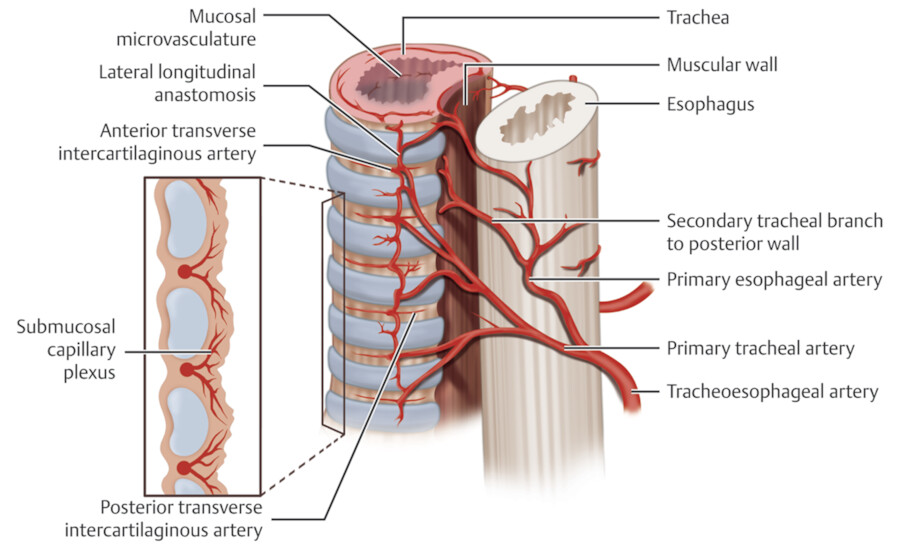
Venous drainage of the trachea is generally into the azygos/hemiazygos system. The lymphatic drainage of the trachea is through the low and high paratracheal nodal chains.
The thoracic sympathetic chain and inferior ganglion of the vagus nerve are responsible for tracheobronchial muscle tone (bronchoconstriction or bronchodilation) and mucous production. Afferent vagal fibers control sneezing and cough reflex.
Carina and Bronchial Anatomy
The trachea bifurcates at the carina into the right and left mainstem bronchi. 16 The tracheal bifurcation is located below the level of the sternal angle anteriorly and the T4 to T5 disc space posteriorly (Fig. 2‑4). The angle between the two main stem bronchi varies among individuals and is generally greater in children than in adults. The right mainstem bronchus lies in a more vertical orientation relative to the trachea, whereas the left mainstem bronchus lies in a more horizontal plane. The right pulmonary artery lies anterior and inferior to the carina. The main pulmonary artery is considerably anterior than the left main bronchus. The right main bronchus passes posterior to the right pulmonary artery. The left main bronchus passes posterior to the main pulmonary artery and inferior to the left pulmonary artery (Fig. 2‑6 , Fig. 2‑7). The left mainstem bronchus is longer than the right mainstem bronchus and it travels underneath the aortic arch to reach the posterior left hilum (Fig. 2‑7). This anatomical course makes surgical manipulation of the left main bronchus difficult.
The diameter of the right mainstem bronchus is an average of 17.5 mm in men and 14 mm in women. 18 The right mainstem bronchus continues as the bronchus intermedius after the takeoff of the right upper lobe bronchus. The average distance from the tracheal carina to the takeoff of the right upper lobe bronchus is 2 cm in men, whereas it is approximately 1.5 cm in women (Fig. 2‑11 , Fig. 2‑12). The right upper lobe bronchus arises several centimeters above the middle lobe bronchus, and the right superior bronchus (B6) arises just inferior to the orifice of the middle lobe bronchus, nearly opposite to it (Fig. 2‑11).
The anatomical distance from tracheal carina to the bifurcation of the left-sided bronchus is approximately 4 to 5 cm in length. It is a little shorter in women. The left main bronchus divides into the left upper and the left lower lobe bronchi (Fig. 2‑12). The common trunk of the left lower lobe is 1 cm longer than that of the right lower lobe (Fig. 2‑12).


The right main bronchus is about 1 mm larger than the left. The bronchus intermedius is approximately 1 mm less than the left main bronchus. The average diameter of the left main bronchus is 16.5 mm in men and 13 mm in women. 15 The average diameter of the right main bronchus is 17.5 mm in men and 14 mm in women. The average diameter of the bronchus intermedius is 15 mm in men and 12 mm in women. In both sexes, the mean diameter of the cricoid was shown to be the same as that of the left main bronchus. 15
Hilar Anatomy
The relationship of the bronchi to the pulmonary arteries differs between the lungs. The right upper lobe bronchus lies behind and beneath the right pulmonary artery, whereas the left main bronchus passes beneath the left pulmonary artery before it gives rise to the left upper bronchus.
The right upper lobe bronchus is called eparterial, since it arises above the superior margin of the right pulmonary artery. The right main bronchus is located below the azygos arc and posterior to the right pulmonary artery. The left upper lobe bronchus is said to be hyparterial, since it originates below the level of the left pulmonary artery (Fig. 2‑13 , Fig. 2‑14). As a matter of fact, in many cases, the left main bronchus is also hyparterial. There are two pulmonary veins in each hilum. The superior vein is located higher and anterior to the inferior vein. On the right side, both are located in the lower half of the hilum below the bronchus and pulmonary artery. On the left side, the left superior pulmonary vein is located anterior to the left bronchus and below the artery whereas the left inferior pulmonary vein is located below the left bronchus.


Segmental Bronchial Anatomy
Anatomical knowledge of the segmental bronchial branch patterns and their variants is very important for radiologists and pulmonologists in order to localize, diagnose, and even treat lesions.
Advanced endoscopic techniques as well as the possibility of virtual bronchoscopy using high-resolution CT images have opened new ways to study the bronchial system. 19 , 20 , 21 Multislice CT can cover the entire lung during a simple breath hold and create high-quality volumetric data allowing generation of superior multiplanar and volume-rendered images including specific techniques for airway imaging, such as virtual bronchography and virtual bronchoscopy 21 (Fig. 2‑15).
Three types of recognizable nomenclatures are used to classify the airway 22 . In radiology and thoracic surgery, Boyden’s classification is commonly used to describe segmental bronchial anatomy. 23 , 24 The most commonly used by pulmonologists is the Jackson–Huber classification 25 (Fig. 2‑12). In these classifications, the segments and subsegments are classified in accordance with the anatomical space orientation (Table 2‑1). Segmental bronchi (B) are assigned a number from 1 to 10 (please see Fig. 2‑29 at the end of the chapter). Another less popular system is the Yamashita Japanese classification. 26 The difference between these classifications is minimal. In endoscopists’ classification, the anterior bronchi of the upper lobes are labeled B3 (B2 in Boyden’s) and posterior bronchi of the upper lobes are labeled B2 (B3 in Boyden’s). 2
Right | Left | ||
Segmental | Subsegmental | Segmental | Subsegmental |
Upper lobe | Upper lobe | ||
B1, apical | B1a, apical | B1+2, apicoposterior | B1+2a, apical |
B1b, anterior | B1+2b, posterior | ||
B2, posterior | B2a, posterior | B1+2c, lateral | |
B2b, lateral | |||
B3, anterior | B3a, lateral | B3, anterior | B3a, lateral |
B3b, anterior | B3b, anterior | ||
B3c, superior | |||
Middle lobe | |||
B4, lateral | B4a, superior | B4, superior lingula | B4a, lateral |
B4b, lateral | B4b, medial | ||
B5, medial | B5a, superior | B5, inferior lingula | B5a, superior |
B5b, inferior | B5b, inferior | ||
Lower lobe | Lower lobe | ||
B6, apical | B6a, superior | B6, apical | B6a, superior |
B6b, lateral | B6b, lateral | ||
B6c, medial | B6c, medial | ||
B7, medial | B7a, posterior | B7, medial | |
B7b, anterior | |||
B8, anterior | B8a, lateral | B8, anterior | B8a, lateral |
B8b, basal | B8b, basal | ||
B9, lateral | B9a, lateral | B9, lateral | B9a, lateral |
B9b, basal | B9b, basal | ||
B10, posterior | B10a, posterior | B10, posterior | B10a, posterior |
B10b, basal | B10b, lateral | ||
B10c, basal | B10c, lateral | ||
There are 10 segmental bronchi in the right lung and 8 to 10 in the left lung. The right bronchus divides into three lobar bronchi and the left main bronchus divides into two lobar bronchi (Fig. 2‑15). The first branch of the right bronchus is the right upper lobe bronchus arising 1 to 2.5 cm below the carina and courses laterally for a distance of 1 to 2 cm before trifurcating into the apical, anterior, and posterior segments. This is the only bronchus in the tracheobronchial tree that has three orifices. 25 The orifice of the right upper lobe is a very important landmark to identify while performing fiberoptic bronchoscopy in order to distinguish the right from the left mainstem bronchus. The apical segment divides into the anterior and apical subsegments. The posterior segment moves posteriorly and divides into the anterior and lateral subsegments. The anterior segment divides into the anterior and lateral subsegments.
After the origin of the right upper bronchus, the right bronchus is called the intermediate bronchus (bronchus intermedius). It measures 2 to 2.5 cm in length and then splits into the middle lobe bronchus and the lower lobe bronchus. The intermediate bronchus can easily be identified in CT images. It runs posterior to the right pulmonary artery and inferior and medial to the right interlobar artery.
The right middle lobe and the superior (apical) segment of the right lower lobe arise approximately at same level. It has the shape of a letter D intraluminally. The right middle lobe emerges anterolaterally with a 1 to 2 cm length before it divides into the medial and lateral segments. These two segmental branches move in the X–Y plane and hard to differentiate on posteroanterior chest radiograph. The lateral segmental bronchus is visualized over a greater distance. The right lower lobe divides into one superior segment and four basal segments. The superior segment delimits the posterior end of the bronchus intermedius. It divides into the medial, superior, and lateral subsegments. The basal segments of the right lower lobes include the posterior, lateral, anterior, and medial subsegments (Fig. 2‑12).
The left main bronchus divides into the upper and lower lobar branches. The left upper lobe bronchus has a superior and an inferior (lingular) division (Fig. 2‑15). The superior division divides into the apicoposterior and anterior segments. The apicoposterior bronchus may be single or divide into the apical and the posterior segments. The anterior segment defines of the inferior border of the left upper lobe. The lingular branch extends 2 to 3 cm downward in an inferolateral direction before dividing into the superior and inferior segments. The left lower lobe divides into a superior segment and three basal segments namely the anteromedial basal, lateral basal, and posterior basal. The anterior basal and medial basal are collectively called anteromedial basal segment. Isolated medial basal segment may be present in one-third of the population.

Characteristics of Small Airways
In contrast to the main bronchi, the hyaline cartilage in the wall of the secondary (segmental) and tertiary (subsegmental) bronchi is patchy and these airways contain more smooth muscles and their mucosa is lined with pseudostratified ciliated columnar cells containing mucus-secreting glands (Fig. 2‑16). The tertiary bronchi subdivide into the bronchioles and at the level of the secondary lobules where 3-5 terminal bronchioles are located intramural cartilage is absent. The terminal bronchioles (final section of the conducting airway) are lined with simple cuboidal epithelium containing club cells but without goblet cells. The diameter of bronchioles is approximately 0.3 to 2 mm. The respiratory bronchioles are divisions of the terminal bronchioles and connect with the alveolar ducts and sacs that are responsible for gas exchange. Small airways of less than 2 mm in diameter are low resistance and normally contribute about 10% of the total resistance to flow. 26 Obstruction of these small tubes may remain asymptomatic because air can enter the air spaces beyond the occluded airways via collateral channels. Another important difference between large and small airways is that the total cross-sectional area of small airways can be several orders of magnitude greater than the total cross-sectional area of the large airways. Presence of a surfactant with a low surface tension in small airway protects them from closing at low lung volumes.
Stay updated, free articles. Join our Telegram channel

Full access? Get Clinical Tree



